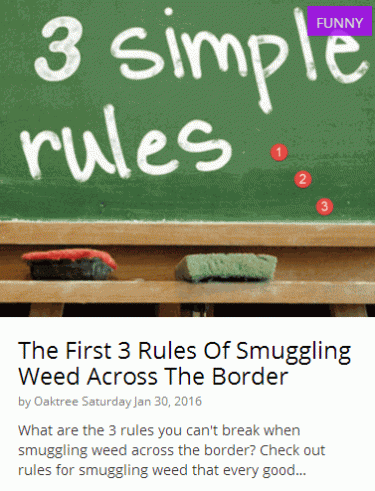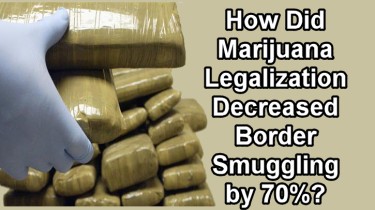
Why is cannabis smuggling over 350% of a US-Canadian border crossing?
In the past decade, customs officials and other agents operating on the Michigan, United States-Ontario, Canada border have confiscated over 14,000 pounds of weed.
In 2018, less than 3,000 pounds of cannabis were seized at the same border. This suggests that recent incidents are five times more than those that were seized just three years ago. The size of the shipments is growing from month to month. One wonders how much cannabis goes through the borders without the knowledge of the authorities. For 14,000 pounds of pot that was supposed to be confiscated on the Michigan border, how many pounds of pot came over the border.
History of cannabis seizures at US borders
About 12 to 18 years ago, the largest shipment of marijuana caught smuggling into the United States would have cost anywhere from £ 60 to £ 100. Now everything is a different case. Smugglers now move contraband in thousands of pounds.
Reports received in recent months show that cannabis smuggling is rampant not just on the northern borders, but everywhere. Officials at the Canada-US border in Buffalo, New York, also confiscated over 40,000 pounds of cannabis from January to September 2021. In 2016, the number fluctuated a bit at around £ 1,000.
In 2016, cannabis seizures were widespread on the southern borders. These borders previously served as the conventional route for marijuana to enter the United States. In 2016, a total of around 730,000 pounds were seized at southern checkpoints, but less than 200,000 pounds were seized this year.
Ontario and Michigan are legal states of cannabis. Why smuggle?
The two states are connected by the Detroit River. Canada has federal cannabis legislation while the United States does not. Michigan, however, is a cannabis rule of law. This means that both states have laws that support the cultivation of cannabis within their borders.
The concept of these types of boundaries is just fascinating at times. You can be in Michigan and just one glance over the water shows you the developing parts of Ontario.
At night, you can see the glow of the cannabis greenhouses just a short distance away in rural Ontario. These greenhouses are the growing areas for huge amounts of cannabis in Canada.
Homeland Security reported that all seized cannabis should be transported to areas far away from Ontario or Michigan. The lake was the main reason the plants got through these borders.
According to the report, most of the confiscated products were moved to the south, where there are no cannabis laws. States like Carolina, Tennessee, and Georgia are usually supplied with smuggled drugs from Ontario, Canada.
The same can be observed for the smuggling of cannabis from the southern borders. Once these products are exceeded, these products are usually shipped to opposite ends of the country. Only in this way can black market operators maximize their profits. Brian McNeal, the appointed field spokesman for the Detroit branch of the DEA, said logic suggests that none of the drugs smuggled through the Ontario – Michigan route are intended for residents of Michigan.
Transporting weed from Ontario to Canada
To transport this contraband from Canada, smugglers use their cars, large vehicles like trucks and some even go so far as to escape customs and border officials at the border in a mini-submarine.
Sometime in mid-2020, a Canadian man named Glen R. Mousseau was caught trying to smuggle in 256 pounds of marijuana using a personal submarine popularly known as the Seabob. Mousseau was seen passed out somewhere on the Detroit River, some suspect he would have penetrated if he hadn’t passed out.
This arrest showed that black market operators of cannabis could do anything to smuggle their products into a country or state. These smugglers are prepared for innovative technologies and have developed sophisticated ships to transport their products. Fortunately, border guards are also using innovative technology to detect movement through these routes.
Mathew Stentz, an assistant special agent at Homeland Security Investigations, commented during that time that all smugglers are concerned about profit.
Canadian smugglers target the US states that do not have cannabis legislation as many jurisdictions have saturated markets. The only places where profits can be fully maximized from the potent greenhouse products are in states whose residents are desperate and in need of cannabis products. Profits in these states are affected by supply and demand due to the drug’s legal unavailability.
Bring cannabis in and take money out
The best way to understand smuggling is that for every pound of cannabis that is brought into the country, an amount of cash is subsequently smuggled out. It’s all an illegal, two-way smuggling chain. Not only is cash looted for cannabis, some also take out weapons and other prohibited drugs (cocaine, methamphetamine).
Officer Stentz added that law enforcement agencies in Canada and the US have teamed up to tackle the high rate of smuggling of criminal organizations. He said the smugglers often take cash and cocaine with them on the way back to the base.
Before Mosseau was arrested in mid-2020, he was arrested in May for attempting to smuggle thousands of dollars in cash into Canada. After his arrest, he pleaded guilty to being part of a criminal organization that smuggled contraband and currency from Canada to the US and vice versa.
Find the real culprits
In most cases, the people found transporting these drugs are not the real culprits. The aim of the security organs involved is to bring these defendants into connection with the real goals. The real targets in this case are large criminal networks that people like Mousseau employ for their dirty work. These cases are likely to stop when the US finally passes statewide cannabis use legislation. Only then will smugglers find it less attractive to bring contraband into the country.
CANNABIS SMUGGLING STORIES, READ MORE ..

3 RULES FOR SMUGGING grass across the border, read this!
OR..

HOW LEGALIZATION HAS REDUCED MARIHUAAN SMUGGLING BY 70%

Post a comment: